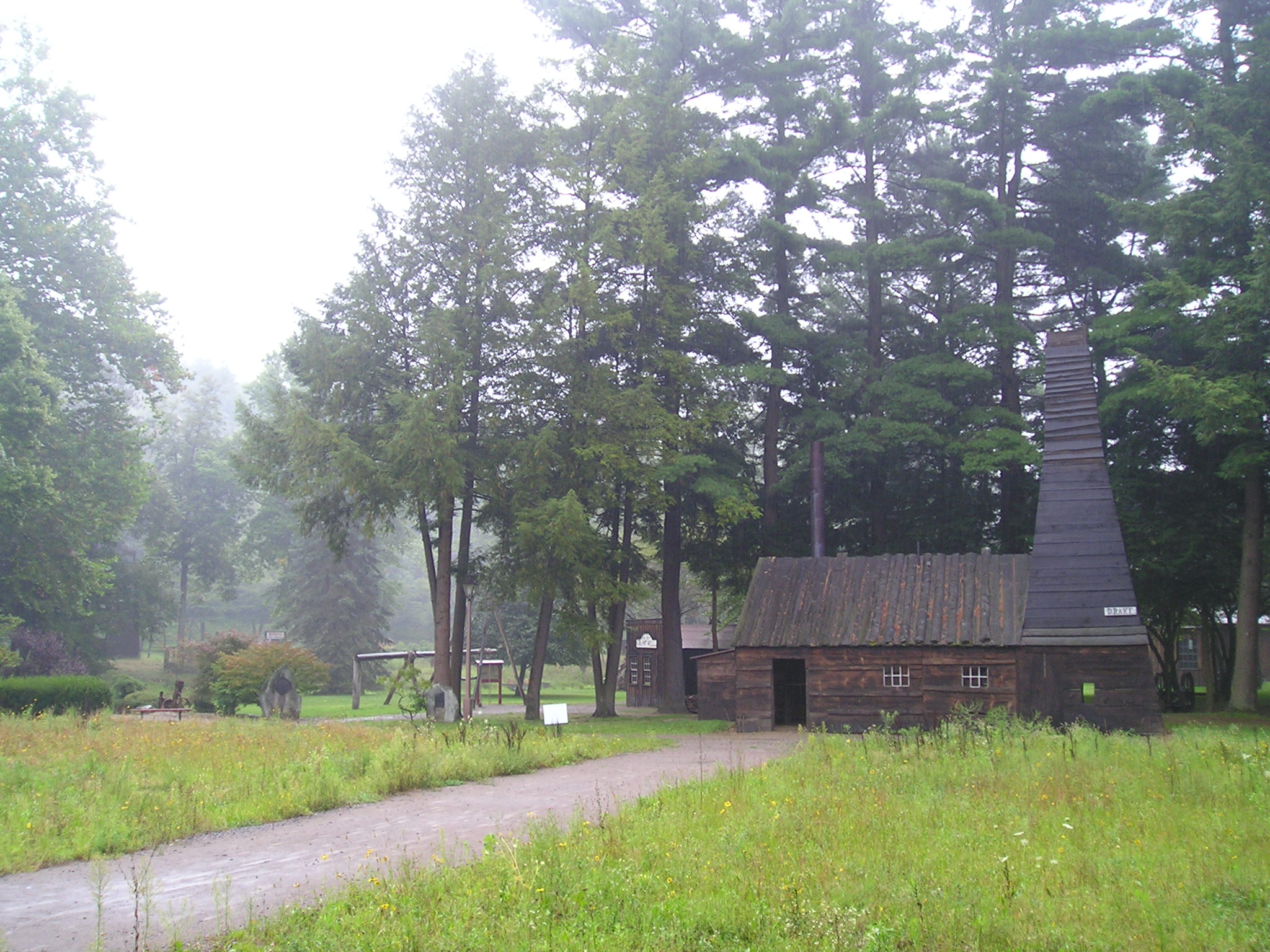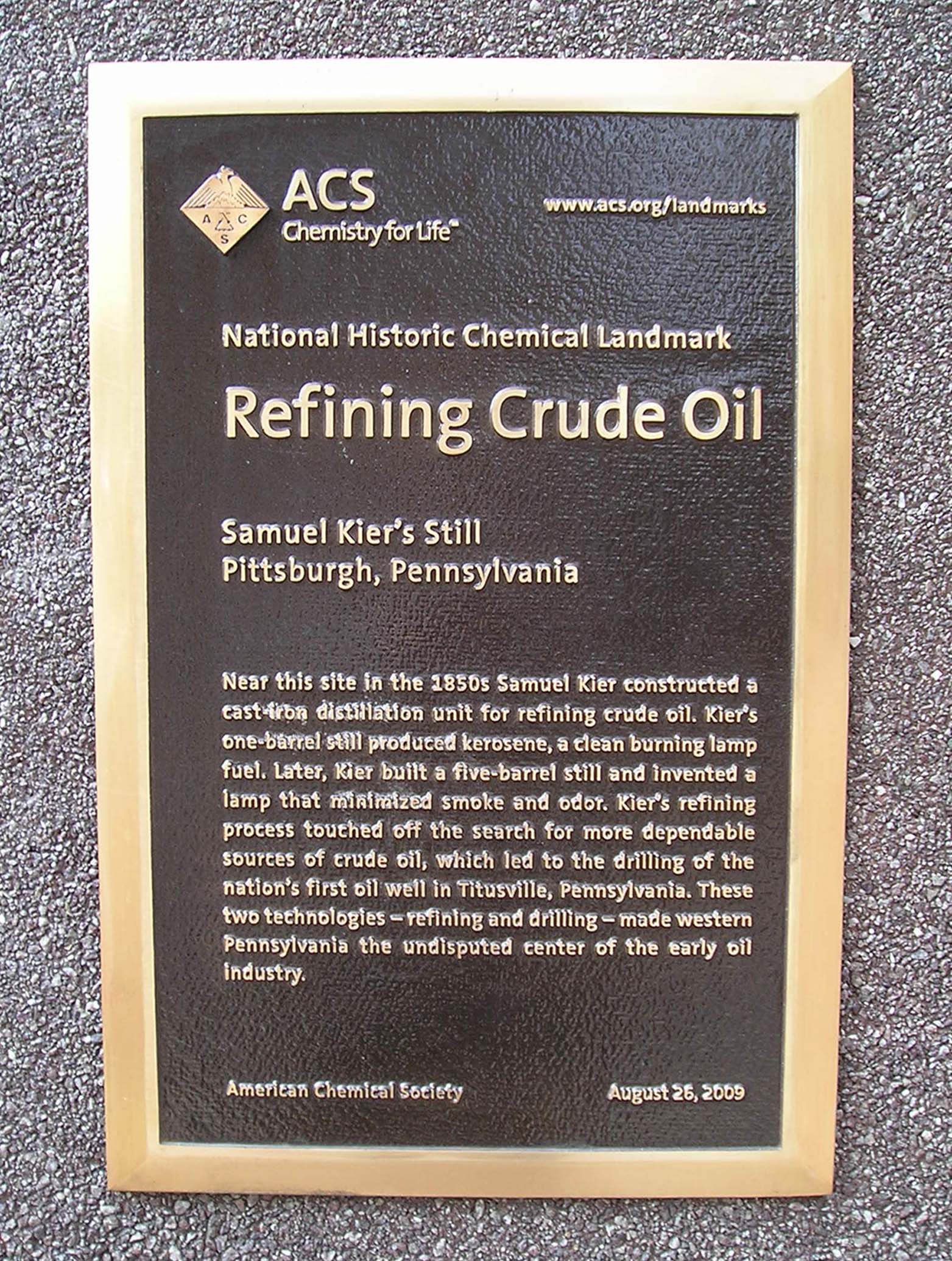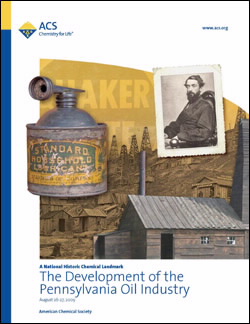Development of the Pennsylvania Oil Industry
Dedicated August 26, 2009, at the U.S. Steel Tower in Pittsburgh, Pennsylvania, and August 27, 2009, at the Drake Well Museum in Titusville, Pennsylvania, during the 150th anniversary of the discovery of oil by Edwin Drake.
Long before Texas gushers and offshore drilling, and a century before oil wells dotted Arabian sands and rose out of Venezuelan waters, the center of petroleum production was western Pennsylvania. In the middle of the 19th century two developments occurred that guaranteed Pennsylvania’s dominance: The construction, in Pittsburgh, of the first still to refine crude oil into kerosene for use in lighting, and the drilling of the first oil well in Titusville, Pennsylvania.
Contents
History of Oil before Modern Petroleum
While the drilling of oil — which marks the start of the modern petroleum industry — dates only to the middle of the 19th century, the knowledge of oil is very old. Oil was used more than five thousand years ago in Mesopotamia; bitumen was mined by the Sumerians, Assyrians, and Babylonians, who used it in architecture, building roads, caulking ships, and medicines. Later, knowledge of oil and its uses declined; the Romans, for example, regarded petroleum as a curiosity only.
But the knowledge never fully disappeared since oil seeps to the surface in many parts of the world. This is true in northwestern Pennsylvania, where the Seneca tribe, part of the Iroquois nation, collected seep oil for hundreds of years, using it as a salve, insect repellent, and tonic. Europeans called the dark, gooey substance Seneca Oil and found it effective for treating sprains and rheumatism. It also burned, but was unappealing as a lamp oil due to its unpleasant odor and smoke.
Candles and whale oil provided most of the artificial light in the decades before the Civil War. Whale oil was also used for lubrication. But demand intensified—and prices skyrocketed—with the development of mechanized transportation and industrialization. This demand fueled the search for new sources of light.
In the 1840s, scientists in Britain began producing an illuminant from the distillation of coal. Dr. Abraham Gesner, a Canadian geologist, made the first successful coal oil in North America, using a bituminous mineral found in New Brunswick. Gesner called it “keroselain” from the Greek word for ”wax” and “oil,” which soon became kerosene.
Samuel Kier Experiments with Pennsylvania Oil
Others tried using petroleum — originally marketed as a medicine — as an illuminant. Seeping petroleum plagued salt well operators as it frequently came to the surface with salt brine. At Tarentum, Pennsylvania, twenty miles north of Pittsburgh, Samuel Kier and his father owned salt wells which produced an annoying quantity of oil along with the desired brine.
Kier thought the oil contaminating his wells was similar to the “American Medicinal Oil” his wife took for a serious illness. Chemical analysis proved the two oils identical, and in 1852 Kier started marketing the oil from his wells as “Kier’s Petroleum, or Rock Oil.” Kier claimed his “medicine” (sold in 8 oz. jars for 50 cents) cured burns, ulcers, cholera, asthma, indigestion, rheumatism, and blindness.
Kier’s salt wells produced more petroleum than he could sell, so he began looking for other uses for it. He sent a sample to Professor James Curtis Booth of the Franklin Institute in Philadelphia, later president of the American Chemical Society. Booth had established in 1836 the first commercial chemical laboratory in the United States. His analysis determined that petroleum could be distilled for use in lighting. Armed with a drawing provided by Booth, Kier built a one-barrel, cast-iron still on Seventh Avenue in Pittsburgh and began to sell distilled petroleum, which he called “carbon oil,” for a $1.50 a gallon.
At the time there was no suitable lamp in which to burn Kier’s kerosene. He began experimenting with lamp burners to let more air enter, which allowed the oil to burn more brightly, although it still gave off a disagreeable odor. But the light was clear and the price reasonable, so Kier built a larger, five-barrel still. After the city council forbade distilling oil because of the danger of fire, Kier moved his operations outside Pittsburgh city limits.
Others succeeded in removing the disagreeable odor by treating oil with acids. Still, the utility of using petroleum as an illuminant was limited by the difficulty of getting it out of the ground.
The Pennsylvania Rock Oil Company is Founded
In the early 1850s a New York lawyer named George Bissell came across a sample of petroleum from Titusville, Pennsylvania. Bissell noted its resemblance to coal oil, and he and his partner, Jonathan Eveleth, sent an agent to investigate its source. The agent gave a favorable report, and the two lawyers proceeded to organize the Pennsylvania Rock Oil Company.
Among the company’s backers was James Townsend, a bank president, whom Bissell and Eveleth met in New Haven, Connecticut. Townsend had concluded that there was money to be made in oil. But friends and associates were slow to buy stock in the new company absent of scientific analysis of the oil to determine its uses and availability. One expert deemed the oil from Titusville to have excellent qualities, but the investors demanded further proof.
Bissell and Townsend retained Benjamin Silliman, Jr., professor of chemistry at Yale University, to make a more refined analysis. After several months of study, Silliman concluded that the company possessed “a raw material from which, by simple and not expensive process, [it] may manufacture very valuable products.” Silliman’s analysis indicated that crude oil could be distilled for use in lamps as kerosene, and he recognized that paraffin could be obtained by high-temperature distillation of the raw material. He underestimated the possibility of using oil for lubrication, but his report was generally so favorable that the Pennsylvania Rock Oil Company which had originally been incorporated in New York was reorganized under Connecticut law — which was more favorable to stockholders — with Silliman as president, Bissell and Eveleth retaining a controlling amount of stock, and the New Haven stockholders supplying a majority of the Board of Directors.
Oh, Townsend, oil coming out of the ground, pumping oil out of the earth as you pump water? Nonsense! You’re crazy.”
Quoted in Paul H. Giddens, The Birth of the Oil Industry, (New York: The MacMillan Company, 1938), p. 48.
Colonel Edwin Drake and the First Oil Well
Colonel Edwin Drake is famous for drilling the first oil well in 1859. Much about Drake and his well is accidental. Even his title — Colonel — came not from military advancement but because Townsend thought it lent prestige to Drake and the quest for oil.
When Drake and Townsend met, Drake was in his late 30s, having spent much of his adult life working for railroads. Townsend sold Drake $200 worth of stock — his total life savings — in the Pennsylvania Rock Oil Company. Townsend decided to send the new investor, whose previous railroad work entitled him to free transportation, to Pennsylvania to secure title to lands for the company and to report on the prospect of finding oil.
Drake inspected the oil country and told Townsend that a fortune could be made in petroleum. Encouraged by this news, Townsend arranged for the company to be reconstituted as the Seneca Oil Company with Drake as largest stockholder and president. The company also hired Drake as general manager for the princely sum — to him — of $1,000 a year. In May 1858 Drake moved to Titusville, did some more scouting around, and decided to drill a well.
Drake needed two things to drill: equipment and someone with experience boring into salt wells. The equipment was easy; Drake ordered an engine, built a pump house, and asked Townsend for $1,000 to pay for the supplies. The expert proved more difficult to find. Drake spent several months in 1858 and 1959 trying to find a driller. Potential recruits thought Drake “crazy” to drill for oil.
Finally Drake found William Smith, a blacksmith who had made tools for Samuel Kier and who had done some drilling. “Uncle Billy” Smith agreed to work for $2.50 a day, make his own tools, and throw in the services of his 15-year-old son. Smith arrived in Titusville in May, 1859, and found that Drake’s men had been digging a hole 150 feet from Oil Creek.
Smith discovered that the hole — located close to the creek and below the level of the stream — kept filling with water. He tried pumping out the water, with little success. Finally, Drake and Smith obtained cast iron pipe which they drove about 32 feet into the bedrock — past the water — using a white-oak battering ram. In mid-August Smith began drilling his well, through the pipe, with steam power, averaging about three feet a day.
The slow progress invited gibes from the locals. More seriously, the investors decided to pull the plug, with Townsend directing Drake to shut down operations. Before receiving these instructions, Drake borrowed $500 locally. The loan allowed him to pay off his creditors and continue work, though Drake must have feared the end was near.
On Saturday, August 27, with the drill at a depth of 69 feet, work stopped. Everyone expected to have to drill at least several hundred feet deeper. The next day, “Uncle Billy” inspected the well and saw fluid at the top of the pipe. Smith realized it was oil. News soon spread along Oil Creek and into Titusville, but Drake did not get the word until Monday morning when he arrived at the well and saw Smith surrounded by barrels, tubs, and jars of oil. No one realized it at the time, but Drake had drilled in the only spot in the region where oil could be found at such a shallow depth as 69 feet.
Development of the Pennsylvania Oil Industry
By the end of 1859 wells sprouted throughout the oil country. Those pioneer wells produced about 4,500 barrels that year. In 1860 wells in northwestern Pennsylvania produced several hundred thousand barrels and by 1862 production reached three million barrels. The nation’s oil bonanza had begun, and huge fortunes would soon be made.
But not by Colonel Drake. He failed to act quickly to control production and he had not bought much land in the area. In 1860 the Seneca Oil Company severed its connection to Drake, paying him $1,000 for the use of his name on oil barrels.
By the end of the Civil War Drake had lost all his money and his health. He moved first to Vermont and then to New Jersey because he thought the sea might improve his health. In the late 1860s old acquaintances from the oil industry raised $4,000 for Drake. In 1873 the Pennsylvania legislature allotted Drake $1,500 annually. In November 1880, after years of bad health and constant pain, Drake died poor and a pensioner, never having benefitted from “discovering” oil in Titusville, Pennsylvania, on August 27, 1859.
Swelling production of Pennsylvania oil led to a rapid drop in price, which drove many producers out of business but which also drove consumers away from other sources of illumination, allowing Pennsylvania oil to corner the market.
The cycle of boom and bust plagued Pennsylvania oil production until John D. Rockefeller organized Standard Oil and imposed order on the industry in the 1870s. In the next decade Thomas Edison’s light bulb and electrification would replace kerosene, threatening the dominance of oil. The petroleum industry would be saved, in turn, by the coming of the automobile and the need for gasoline, which would be supplied by other areas of production, particularly Texas, and then foreign sources. But in the latter part of the 19th century, Pennsylvania oil dominated the market, pointing the way to America’s eventual reliance on petroleum.

Landmark Designation and Acknowledgments
Landmark Designation
The American Chemical Society designated the development by Samuel Kier of the first still for refining crude oil as a National Historic Chemical Landmark in a ceremony in Pittsburgh, Pennsylvania, on August 26, 2009. The plaque commemorating the event at the Kier still location (now U.S. Steel Tower) reads:
Near this site in the 1850s Samuel Kier constructed a cast-iron distillation unit for refining crude oil. Kier’s one-barrel still produced kerosene, a clean burning lamp fuel. Later, Kier built a five-barrel still and invented a lamp that minimized smoke and odor. Kier’s refining process touched off the search for more dependable sources of crude oil, which led to the drilling of the nation’s first oil well in Titusville, Pennsylvania. These two technologies — refining and drilling — made western Pennsylvania the undisputed center of the early oil industry.
The American Chemical Society designated the drilling by Edwin Drake of the first oil well in a ceremony in Titusville, Pennsylvania, on August 27, 2009. The plaque commemorating the event at the Drake Well Museum reads:
On this site Edwin Drake drilled the world’s first oil well, striking oil on August 27, 1859. Crude oil — which seeps to the surface in this part of Pennsylvania — was often collected and used medicinally to treat rheumatism and sprains. Later, refined oil began to be burned in lanterns. The demand for oil grew, setting off a search for a way to recover the large quantities of oil thought to exist below the surface. Drake, with the assistance of William Smith, known as “Uncle Billy,” found oil at a depth of 69 ½ feet, prompting the first American oil boom. As a result, western Pennsylvania became the undisputed center of the early oil industry.
Acknowledgments
Adapted for the internet from “The Development of the Pennsylvania Oil Industry,” produced by the National Historic Chemical Landmarks program of the American Chemical Society in 2009.
Back to National Historic Chemical Landmarks Main Page.
Learn more: About the Landmarks Program.
Take action: Nominate a Landmark and Contact the NHCL Coordinator.



